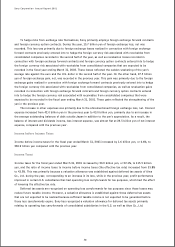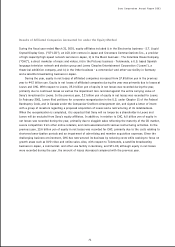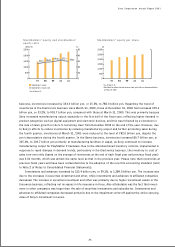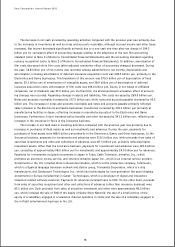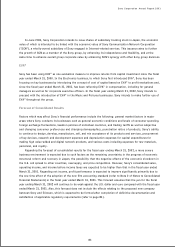Sony 2001 Annual Report Download - page 76
Download and view the complete annual report
Please find page 76 of the 2001 Sony annual report below. You can navigate through the pages in the report by either clicking on the pages listed below, or by using the keyword search tool below to find specific information within the annual report.
Sony Corporation Annual Report 2001
74
Sony is centralizing and pursuing global efficiency of its cash management. In Japan, the excess or shortage
of cash of most of its subsidiaries is collectively invested or funded at Sony Corporation through intra-group
deposits and loans. Sony has introduced a cash centralizing system in which all the funds collected by domestic
subsidiaries are automatically centralized in Sony Corporation’s master bank account through zero balance
arrangements, and Sony Corporation arranges payments on behalf of domestic subsidiaries so that those subsid-
iaries do not have to hold cash. Also, since the fiscal year ended March 31, 2000, Sony has been managing its
excess cash globally among finance subsidiaries in the U.S., the United Kingdom, Singapore, and Sony Corporation
in order to improve the use of available cash balances and to reduce excess cash as well as debt. As of March 31,
2001, a total amount outstanding of approximately 83.0 billion yen was lent from cash-surplus subsidiaries in
Asia to financial subsidiaries in other regions. In the fiscal year ended March 31, 2001, Sony established a
subsidiary named Sony Global Treasury Services, plc. to integrate and rationalize the Sony group’s treasury
transactions and continue to improve efficiency of financing operations in the future.
Sony’s financial condition remains strong. Sony believes that it maintains sufficient liquidity through its cash
and other liquid assets, and that in order to fund ongoing operating requirements and investments related to the
expansion of existing businesses and the development of new projects, it is able to secure adequate resources
through its access to financial and capital markets.
Assets, Liabilities and Stockholders’ Equity
Total assets at March 31, 2001 increased by 1,020.8 billion yen, or 15.0%, to 7,828.0 billion yen compared with
the previous fiscal year-end. (Total assets were affected by currency translation. It is estimated that total assets
at March 31, 2001 would have increased by approximately 9% compared with the previous fiscal year-end if the
value of the yen had remained the same at March 31, 2001 as at the previous fiscal year-end.) The increase was
primarily attributable to increases in securities investments and other, inventories, and tangible fixed assets.
Current assets increased by 455.5 billion yen, or 15.1%, to 3,477.5 billion yen. This increase was primarily
due to increases in notes and accounts receivable, trade and inventories. Among current assets, notes and
accounts receivable, trade, less allowance for doubtful accounts and sales returns increased by 239.8 billion
yen, or 22.7%, to 1,295.3 billion yen due to sales increases primarily in the Electronics and Game businesses.
Inventories increased by 196.3 billion yen, or 26.3%, to 942.9 billion yen primarily at manufacturing facilities in
Japan, reflecting increases in manufacturing output in the Electronics and Game businesses. In the Electronics
Short-term (Including the current portion of long-term debt)
* As of March 31
Long-term
(Billion ¥)
Interest-bearing liabilities
0
500
1,000
1,500
97 98 99 00 01








